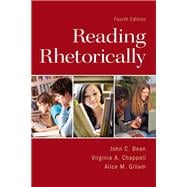Offering concise yet thorough treatment of academic reading and writing in college, Reading Rhetorically, 4th.ed., shows students how to analyze texts by recognizing rhetorical strategies and genre conventions, and how to incorporate other writers’ texts into their own research-based papers.
Four important features of this text:
1. Its emphasis on academic writing as a process in which writers engage with other texts
2. Its emphasis on reading as an interactive process of composing meaning
3. Its treatment rhetorical analysis as both an academic genre that sharpens students' reading acuity and as a tool for academic research
4. Its analytical framework for understanding and critiquing how visual texts interact with verbal texts
This brief rhetoric teaches students how to see texts positioned in a conversation with other texts, how to recognize a text's rhetorical aims and persuasive strategies, and how to analyze texts for both content and method.








